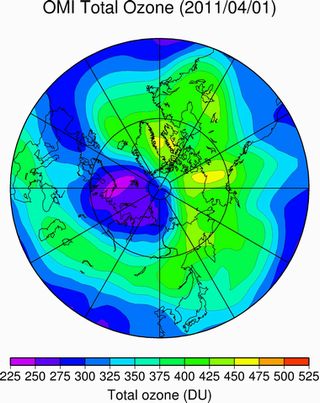August 23, 2011
Record 40% Loss Detected in Arctic Ozone Layer
Keywords: Ecosystems / Biodiversity University / Research institute

Copyright National Institute for Environmental Studies
A record loss of ozone was detected at 30 monitoring stations, called ozonesondes, in 15 countries in the Arctic region through the winter into spring 2011, the National Institute for Environmental Studies (NIES) announced on April 6. NIES also stated that the Arctic ozone loss is still growing, and that higher-than-normal levels of ultraviolet radiation can be expected for the season because of the depletion.
Atmospheric concentrations of active chlorine have declined, thanks to effective regulation of chlorofluorocarbon emissions under the Montreal Protocol. (Active chlorine is a harmful ozone-depleting substance.) Despite the decline in concentrations, however, an unprecedented level of ozone depletion has been observed in the Arctic polar vortex as far south as Scandinavia, according to the global ozone-observing network coordinated by the World Meteorological Organization (WMO).
A meteorological model predicts that the ozone-depleted air will move east toward Russia and likely reach as far as its border with China. "The Arctic region has suffered an ozone column loss of about 40 percent from the beginning of the winter to late March," the WMO said. It has already exceeded the highest previous recorded loss of 30 percent.
There are serious concerns that increasing greenhouse gasses will contribute to meteorological conditions that could trigger large-scale Arctic ozone depletion. NIES stresses that close observation of the Arctic atmosphere will be necessary in the coming years, as well as continued monitoring of the any recovery of the Antarctic ozone hole.
Posted: 2011/08/23 06:00:15 AM
Reference
National Institute for Environmental Studies (NIES) official website
http://www.nies.go.jp/index.html
Related
"JFS Newsletter"
- 'What Are the Roles of Zoos Today?' - Interview with Director of the Popular Asahiyama Zoo
- Nishiawakura's Initiative for 100% Energy Self-Sufficiency, and a Municipal ICO Scheme
- 15-Year Integrated Forest Environment Education in Shimokawa, Hokkaido to Support Sustainable Forest Management
- Fifth Contest to Award Excellent Environmental and Social Practices by Junior High, High School Students
- Increase Revenues without Increasing Catches -- How the Sustainable Sakura Shrimp Fishery in Suruga Bay Does It


